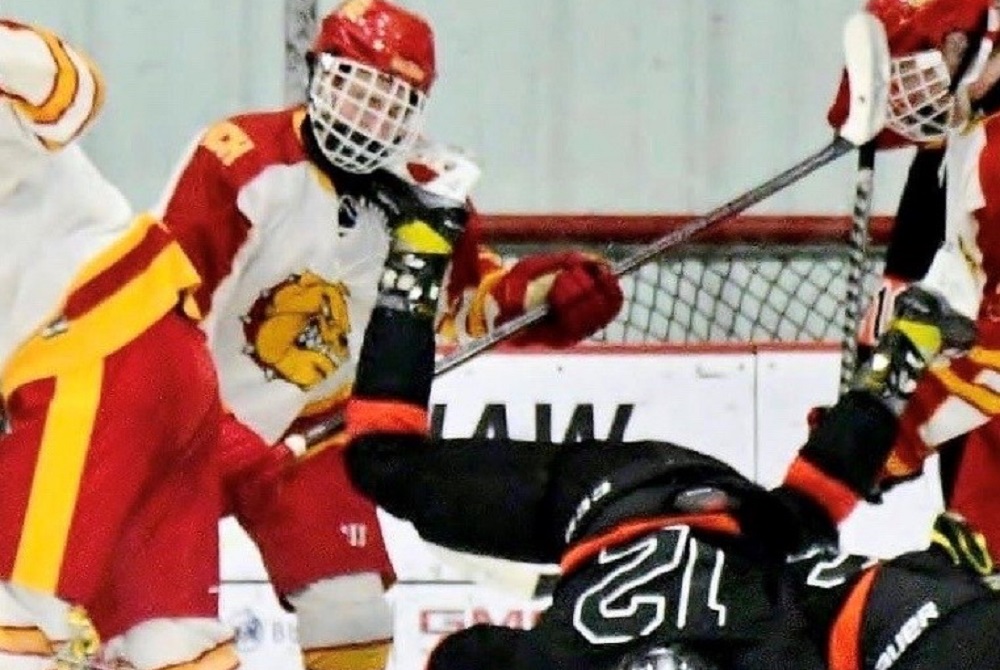
MHSAA Neck Guard Requirement Rooted in 1999 'Impossible to Forget' Injury
By
Ron Pesch
MHSAA historian
February 3, 2022
Dan DiCristofaro has made it a mission to remind schools, coaches, athletic directors, and other officials of the need to enforce an equipment rule, added to the MHSAA hockey rule book more than 20 years ago.
“Officials are not trying to give out misconduct penalties,” wrote DiCristofaro in a recent email, “but the avoidance by so many players to wear this piece of equipment as intended in its unaltered state or to even wear a neck guard at all has become almost the norm instead of the exception.”
“This is mandatory,” emphasized the long-time hockey official during a recent conversation. “It’s required, not recommended. Required.”
As a witness to an unforgettable occurrence during a game, DiCristofaro wants others to do what they can to reduce the odds of that moment happening again.
Rivals
The Wednesday, Feb. 10, 1999, game between Trenton and Redford Catholic Central was a rematch – the second game of a home-and-home series that had been played for years. Two of the state’s hockey powerhouses, the foes were certainly familiar with each other.
“The rivalry between Trenton and Catholic Central has probably gone on since the 60s,” recalled Trenton coach Mike Turner.
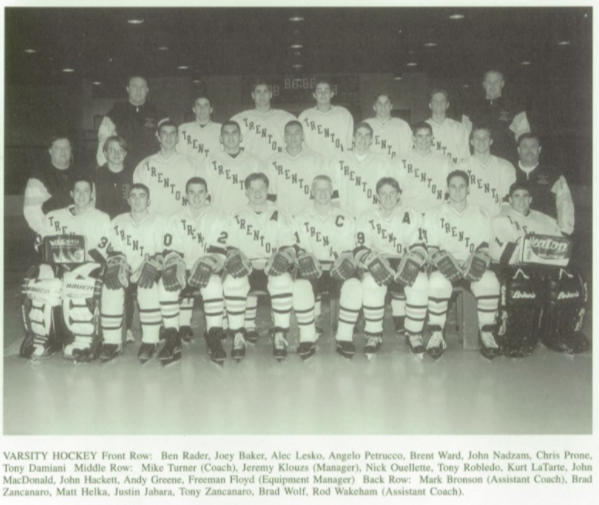 “They were usually two of the best teams in the state,” added Gordon St. John, Catholic’s coach at the time.
“They were usually two of the best teams in the state,” added Gordon St. John, Catholic’s coach at the time.
Both coaches were speaking in 2010, for REPLAY, a sports television series created by Gatorade, built around the re-staging of games between high school rivals. Fox Sports Net broadcast the game.
“If you go into our gymnasium, you will find 42 state banners,” noted Fr. Richard Ranalletti, principal at CC from 2000 to 2010. “Thirteen of them are in hockey” (1959, 1961, 1968, 1974, 1994, 1997, 1999, 2000, 2001, 2002, 2003, 2005, 2009). Founded in 1928, Detroit Catholic Central had moved to Redford Township 50 years later. (The campus moved again in 2005, this time to Novi.)
The city of Trenton was founded in 1834. A 1901 report in the Free Press speaks of architect Edward C. Leyen completing plans “for a high school building for the board of education of Trenton.”
“Since 1975, there’s 12 state championship banners (1976, 1979, 1980, 1982, 1986, 1991, 1996, 1998, 2003, 2004, 2008, 2009) hanging in our arena,” said Jerry Brown, Mayor of Trenton in his interview for the program.
Hank Minckiewicz, sports editor for the News-Herald in Trenton, summed it up: “Back in 1999, there was not a bigger rivalry in the state than Trenton and Catholic Central.”
Fifth-ranked Trenton had downed No. 1 CC, 1-0, at Redford Arena earlier in the 1999 season – the Shamrocks’ only loss at that point in the annual chase for a state title. The second game between the schools was played at Trenton’s Kennedy Recreation Center, then a single rink arena, before a full house. Catholic Central opened a 4-1 lead before the Trojans, dressed in their home white jerseys, stormed back to tie the game at 4-4 with about five minutes to play.
Nightmare Come to Life
The moment on the ice, caught on videotape, appears harmless enough.
“Late in the game, a Trenton player knocked a CC player off balance, sending his leg back into the air.” recounted Bill Roose in the Detroit Free Press, describing the freak accident that nearly took the life of Trojans senior Kurt LaTarte.
A 6-foot defenseman, LaTarte had been near the play and initially continued toward the puck, but then circled back and headed to the Trenton bench.
Lori Holcomb, a team trainer for Trenton, recalled the moment for REPLAY, documenting the night.
“Kurt was coming on to the bench, and he was kind of holding the side of his face and his neck and he said, ‘The kid’s boot hit me in the chin … I think my chin is cut.’
‘It was clean and straight,” she continued, “like surgical.”
It wouldn’t remain that way.
Guardian Angels
“The gash across the right side of his neck was four inches long and two inches wide,” wrote Roose in touching on the horror that quickly unfolded.
Chaos erupted on the Trenton bench as the color of LaTarte’s jersey changed from white to red.
“The game was so intense. … It was so jam-packed with people,” remembered DiCristofaro. “You couldn’t even hear yourself because it was so loud. We did not know that this had happened during the game until a linesman who happened to be standing next to the bench saw what was going on. … He’s the one who blew his whistle loud and kept blowing it for the play to actually stop.
“Once it all hit home and the play stopped … everybody went stone silent. Once everybody knew what was happening and everybody was informed, the players started kneeling, a lot of them were crying.”
The game was ended.
“Fortunately,” stated Roose, “(there were) a few guardian angels among the … spectators.”
Dr. David Wolf, nurse Leslie Zancanaro and firefighter Alec Lesko were all at the game because they had sons on Trenton’s team.
Wolf would accompany LaTarte to the hospital, “detailing his injuries to emergency room doctors” at Oakwood/Seaway Hospital in Trenton. Surgery that night repaired vein and muscle damage. On Friday, he was released from University of Michigan Hospitals in Ann Arbor. A week later, LaTarte was back in school.
In a follow-up article in the Free Press, the LaTarte Family thanked all involved with saving Kurt’s life.
DiCristofaro had officiated the game.
The Injury
Regrettably, this was far from the first time a hockey player had suffered such an injury. While certainly not common, and not always fatal, cuts like these are extremely serious. And for all involved – from spectator to player – impossible to forget.
Simply put, carotid arteries carry oxygenated blood to the head, face, and brain through the neck, while the jugular veins passing through the neck handle deoxygenated blood. Disruption to these vessels can quickly create major precarious problems instantly.
Few hockey fans can forget the horrific story of Clint Malarchuk, goalie for the Buffalo Sabres of the National Hockey League, nearly “bleeding to death on the ice when a skate severed his jugular vein,” in 1989. Many had forgotten that a similar injury to carotid arteries occurred to NHL player Jackie Leclair of the Montreal Canadians in 1954. (It would happen again in 2008, this time to Richard Zednick of the Florida Panthers). There have been various near misses and close calls in the NHL and professional hockey’s minor leagues.
Reports of cuts to the neck in Canada appeared in both U.S. and Canadian newspapers, including one causing the death of a 29-year-old father of two, Maurice Ayotte, who was playing amateur hockey in December 1973.
In another instance, a team trainer and a teammate were credited with saving the life of Kim Crouch of the Markham, Ontario Waxers in January 1975. An 18-year-old junior league goalie, he had been cut while making a save. The near tragedy inspired Kim’s father, Edward M. Crouch, to design a neck protector.
 “Maybe this neck guard will prevent other boys from going through what he did,” Edward told The Canadian Press. “It’s a combination of a baby’s bib and a turtleneck sweater.”
“Maybe this neck guard will prevent other boys from going through what he did,” Edward told The Canadian Press. “It’s a combination of a baby’s bib and a turtleneck sweater.”
By the fall of 1976, the initial “Kim Crouch Safety Collar” – weighing 3½ ounces and made of Nylon Ballistic Material and closed-cell foam – was available in stores. Two years later, it was being worn by several NHL and minor league goalies, and within five years, other manufacturers had throat protectors on the market.
Yet, their existence didn’t ensure broad acceptance or use.
It would take a series of tragic episodes that occurred within a span of two years to alter equipment requirements for youth hockey above the border.
In December 1983, a Montreal, Quebec boy, James Lechman, who played for the Class BB Rosemont team, died. Down on the ice in a scramble in front of his team’s net, the Rosemont goalie’s skate accidentally clipped the 15-year-old’s neck while he tried to block a shot.
In October 1984, Henry Reimer of the Richmond, British Columbia Sockeyes, a 17-year-old “standout centre” in the B.C. Junior Hockey League, survived a throat slit suffered when a teammate fell prior to a game during warmups, and his skate clipped Reimer. Fifty stitches – “30 internal and 20 external” – were required to close the wound. “Only the swift action of trainers and ambulance attendants prevented a tragedy,” stated the Vancouver, B.C. Province.
“If it was millimetres, either way,” Sockeyes’ coach Vic LeMire would later say, “he would be a statistic.”
A month later, Stephane Saint-Aubin, an 18-year-old Repentigny Olympiques player in the Junior AA Quebec league, died due to a similar injury. It was his first game with the team.
CCM and Cooper released new or redesigned versions of protectors that covered the neck and upper chest in 1985. Following his injury, Reimer, who would play college hockey on scholarship for the University of Illinois, worked with a Michigan company to develop another design.
But in September 1985, misfortune struck again within the same B.C. Junior Hockey League. Abbotsford British Columbia Falcons forward Jeff Butler, another 18-year-old, died after being cut on the throat by the “freshly sharpened, razor-sharp” blade of a teammate’s skate, according to another Province report.
The exhibition game, played before a crowd of just 200, was called off after the incident, midway through the second period. Doctors had labored to save Butler’s life but were unsuccessful.
“There are not words to describe what happened,” said coach Larry Romanchych to the Vancouver Sun.
Romanchych, who had previously played with Chicago and Atlanta in the NHL, immediately went to work searching for neck protectors. After examining the various types available, he purchased Crouch Collars.
“After what happened Saturday. I will never let my own (12-year-old) son on the ice without one,” vowed Romanchych. “And I will never let anybody who plays for me go without one. (The players) will get used to them, the same way we got used to playing with helmets. It’s just a shame that something … has to happen before we do anything about it.”
New Requirement
Some leagues in Canada took action and began to require players and goalies to wear neck guards. Players complained, stating the guards were uncomfortable and/or too hot to wear, and the rules were not always enforced. Heartbreaking accidents continued to occur.
The Canadian Standards Association (CSA)/Bureau de Normalisation du Quebec (BNQ) began work to establish guidelines for protection to be met by manufacturers. The injury to Malarchuk (an Alberta, Canada native) would ensure the passage of a national directive.
Still, it took time.
Challenges arose for manufacturers to distribute products to Canada’s more than 400,000 players, especially to small cities. That presented some implementation delays, but as of Jan. 1, 1994, it was a requirement to wear a Canadian Standards Association-approved throat protector (sometimes referred to as a neck laceration guard) labeled or stamped with the initials BNQ for all participants across the Canada Amateur Hockey Association.
Another death, this time in Sweden in 1995, moved the country to require all hockey players to wear neck guards.
Back in Michigan
“Neck guards are mandatory for youth hockey players in Canada,” wrote Anjali J. Sekhar days after LaTarte’s injury in an article for the Port Huron Times-Herald. “And while they are not mandatory in the United States, many people believe it’s common sense to wear them.”
While recognizing that the piece of equipment did not guarantee tragedy would always be avoided, the MHSAA still responded promptly to what had happened in Trenton. In May 1999, the MHSAA’s Representative Council, following Canada’s lead, instituted a mandatory neck guard rule for scholastic athletes in 2000.
Like our northern neighbors, the equipment worn by players must bear a label from BNQ. Today, the MHSAA is one of only two high school governing bodies in the United States to require hockey neck guards.
REPLAY by Gatorade
In May 2010, Gatorade reunited former members of the 1999 game from both DCC and Trenton, including LaTarte, their teams’ original coaching staffs, and two of the three officials from the game for a full-check, regulation-length replay of the contest. (Ironically, only weeks before, both schools had won MHSAA hockey titles.)
“For Trenton hockey alumni, redemption has come after years of waiting as they defeated their Detroit Catholic Central counterparts by a score of 4-2,” stated a news release following the contest.
 “From the moment Compuware Arena's doors opened, to the ceremonial puck-drop by game day commissioner, ‘Mr. Hockey®’ Gordie Howe, to the final horn sounding, excitement filled the arena. The teams, which hit the ice in front of nearly 4,000 people, were joined by Detroit hockey legends Scotty Bowman and Brendan Shanahan who provided their expertise and guidance as honorary coaches to the Catholic Central and Trenton squads, respectively.”
“From the moment Compuware Arena's doors opened, to the ceremonial puck-drop by game day commissioner, ‘Mr. Hockey®’ Gordie Howe, to the final horn sounding, excitement filled the arena. The teams, which hit the ice in front of nearly 4,000 people, were joined by Detroit hockey legends Scotty Bowman and Brendan Shanahan who provided their expertise and guidance as honorary coaches to the Catholic Central and Trenton squads, respectively.”
Prior to the game, training for former players had lasted eight weeks.
“We’re thinking this game was going to be more fun and ceremonial and casual,” said DiCristofaro, laughing at the memory. “The first few minutes shocked us with the physicality. This was serious hockey.
“These guys are running at each other. They were 17 and 18 years old again. There were some serious body checks. We had to start intervening immediately before somebody got hurt.
“They really went all-out with training and practice and off-ice conditioning to get ready for this game.”
“I knew this was an awesome opportunity to get the teams together and close this chapter,” said LaTarte. “Seeing how this came together, it was definitely worth every ounce of sweat.”
Prompting the Memory
Sadly, these memories of the happy ending were prompted by another much more recent nightmare. This January, once again, the razor-blade sharpness of an unintended air-bound ice skate took a life, this time in Connecticut. The player was Teddy Balkind, a 16-year-old sophomore at St. Luke’s School in New Canaan. The contest was with Brunswick School, located in Greenwich. In a letter written by Mark Davis, St. Luke’s head of school, to school families and reported in the media, he clarified details of the accident, misreported by some of the media:
“Teddy did not fall and was not lying on the ice. He was skating upright and low. During the normal course of play, another player’s leg momentarily went into the air and, through no fault of anyone’s, or any lack of control, his skate cut Teddy.”
Recommend, but not Require
“’Commercially manufactured throat guards designed specifically for ice hockey are required for all players, including goaltenders during regular season and tournament play,’ Connecticut Interscholastic Athletic Conference rules state,” noted the Toronto Star in coverage. “St. Luke’s and Brunswick play in the Fairchester Athletic Association, which like most prep school conferences follows the policy of USA Hockey and the NCAA, which recommend rather than require neck guards.”
“Founded on Oct. 29, 1937, in New York City … the organization was known as the Amateur Hockey Association of the United States (AHAUS) and changed to its present name in June 1991. While youth hockey is a main focus, USA Hockey also has vibrant junior and adult hockey programs that provide opportunities for players of all ability levels. The organization also supports a growing disabled hockey program.”
The Player Safety and Health Information page on USA Hockey’s website, while recommending neck laceration protectors and expressing concern about such injuries, stated (as of Feb. 3, 2022), “There is sparse data on neck laceration prevalence, severity and neck laceration protector (neck guard) effectiveness.”
“USA Hockey recommends that all players wear a neck laceration protector, choosing a design that covers as much of the neck area as possible. Further research & improved standards testing will better determine the effectiveness of neck laceration protectors.”
 Ron Pesch has taken an active role in researching the history of MHSAA events since 1985 and began writing for MHSAA Finals programs in 1986, adding additional features and "flashbacks" in 1992. He inherited the title of MHSAA historian from the late Dick Kishpaugh following the 1993-94 school year, and resides in Muskegon. Contact him at [email protected] with ideas for historical articles.
Ron Pesch has taken an active role in researching the history of MHSAA events since 1985 and began writing for MHSAA Finals programs in 1986, adding additional features and "flashbacks" in 1992. He inherited the title of MHSAA historian from the late Dick Kishpaugh following the 1993-94 school year, and resides in Muskegon. Contact him at [email protected] with ideas for historical articles.
PHOTOS (Top) The neck guard worn by this player may have prevented injury as another skater toppled in front of the goal. (2) The 1999 Trenton hockey team. (3) The Kim Crouch Safety Collar was the first neck guard of its kind. (4) The 1999 Detroit Catholic Central hockey team. (Top photo by Judy Gill; other photos collected by Ron Pesch.)
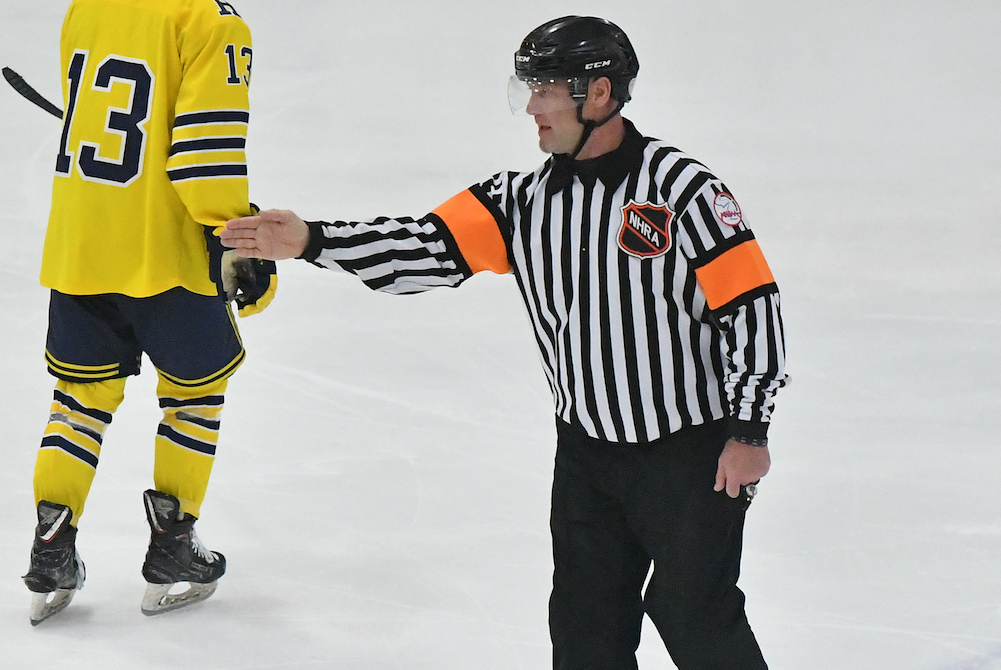
Retired NHL-er Back on Ice to Answer Call - By Making Them
By
Rob Kaminski
MHSAA benchmarks editor
March 16, 2023
The most accomplished skater on the ice during Friday’s triple-overtime MHSAA Division 1 Semifinal hockey thriller between Hartland and Brighton was not wearing the school colors of either team.
In front of a packed house at Plymouth’s USA Hockey Arena, referee Bryan Smolinski was in stripes, just like the rest of his officiating crew.
In his former life, he pulled on plenty of sweaters before lacing up the skates. That happens when one logs more than 1,000 games, tallies nearly 300 goals (274) and close to 400 assists (377) with eight teams spanning a 15-year playing career in the National Hockey League.
So, how did the 52-year-old former star player find himself on the ice last weekend as one of the referees for the pinnacle weekend of this high school season? Good question, even for the man known as “Smoke” during his playing days.
“I was working in youth development programs a few years back and reached out to some Michigan guys I had connections with about other ways to help the game,” Smolinski said. “I called Kevin May just to chat and asked, ‘Hey, how’s your reffing going?’ He said, ‘You know, we’re down a little bit,’ then said, ‘Why don’t you do it?’ I said, ‘Not a chance,’” Smolinski laughed.
Never Say Never
May persisted, imploring his friend to skate with him during a Fall league at Cranbrook in Bloomfield Hills. After eight weeks, once a week, Smolinski had a revelation.
“I’m like, ‘I’m kind of diggin’ this,’” Smolinski said “So, I did all the testing, and the educational part of it, and I really enjoyed it. I got with Danny (DiCristofaro) and his group, and he put me in as much as he could, and I really started to get my feet wet.”
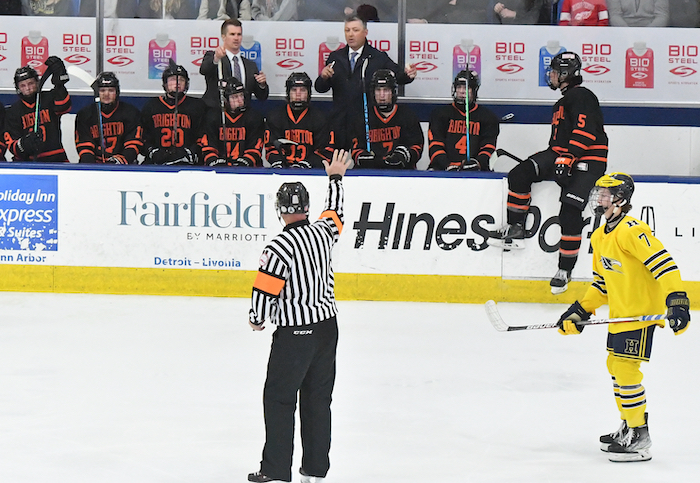 DiCristofaro is the assigner and referee-in-chief for the MHSAA’s Northeast Hockey Referees Association, and he has seen Smolinski’s growth first-hand.
DiCristofaro is the assigner and referee-in-chief for the MHSAA’s Northeast Hockey Referees Association, and he has seen Smolinski’s growth first-hand.
“Obviously he’s got great instincts and a feel for the game, along with a wealth of experience, all of which has allowed him to climb the ladder quickly,” said DiCristofaro. “It’s been a joy to watch his growth as an official.”
Fast forward to last Friday, and there were Smolinski and May sharing duties as referees during the MHSAA Semifinal with linesmen Michael Andrews and Thomas Robbins.
In between, there has been a learning curve that still continues, but the jump to officiating was not quite as daunting as his introduction to the NHL.
“I was scared to death. My first game was against Mario Lemieux. I’m in the old Boston Garden and now I’m playing against these guys and it’s their job, and they’re out there trying to make a living,” Smolinski recalled.
The emotions were not running nearly as frenzied for his first game as an MHSAA official, obviously, yet respect came in a different form.
“I couldn’t pick the puck up, I was breathing heavily; it was Kevin and me doing a two-man game in Brighton,” Smolinski recalled. “There were a few high-end kids playing, and I’m thinking, ‘I’m dying here.’ You know, there’s no training for that first time.”
What that experience did, however, was revitalize Smolinski in a new way. His playing career is well documented, not only in the NHL, but around Michigan. He enjoyed an honor-laden career at Michigan State University from 1989-93 before joining the Boston Bruins (who had drafted him three years earlier) at the end of the ’93 NHL campaign. Even after his final season, with Montreal in 2007-08, he stayed in the game via men’s leagues, or coaching his son, Max.
Smolinski and his wife, Julie, have three daughters: Ashtyn (22), Jojo (16) and Rylen (12), along with Max, whom dad coached for seven years including during a national championship run with a Little Caesars U15 team in 2019. Max, 19, is now playing collegiately at Rensselaer Polytechnic Institute.
So, for Smolinski, officiating offers a new chapter.
“Reffing brought back ... I wouldn’t say love of the game, because that’s always been there; it’s a different side of enjoying the game now. I have no horse in the race, my son’s off to college, my daughters are doing their thing; I wanted to find something new in the game,” Smolinski said. “I’ve coached, and I don’t want to do that. I found this, and I’ve stuck with it.”
Old College Ties
One of the great benefits of athletics at any level are the friendships made. For two kids who met in their first years on the MSU campus and forged a bond that lasts to this day, it’s amazing how their careers reached the pinnacle and have now come full circle.
Wes McCauley, an MSU teammate, is one of Smolinski’s best friends. After numerous years in the minor leagues, McCauley, like his friend, made it to the NHL. But McCauley made it as an official, working his first NHL game in 2003, when Smolinski was nearing the end of his playing career.
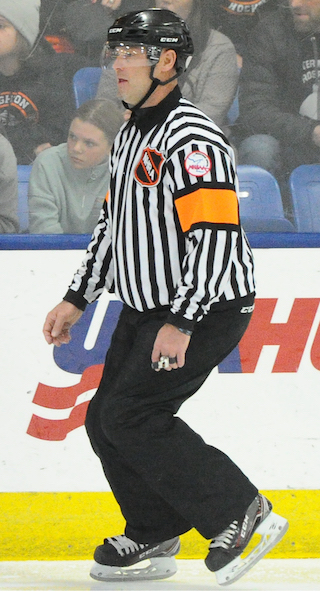 Their games lined up on just a few occasions in the NHL, and the two lobbied hard to have McCauley work Smolinski’s 1,000th career game in his final season with the Canadiens in 2007-08. The request, sadly, was denied by the league.
Their games lined up on just a few occasions in the NHL, and the two lobbied hard to have McCauley work Smolinski’s 1,000th career game in his final season with the Canadiens in 2007-08. The request, sadly, was denied by the league.
On the rare occasions when the friends did share the same ice, less than a handful by Smolinski’s count, it was McCauley who was forced to rebuff any attempts at fraternization. It’s just part of an official’s edict.
“For both of us, it was amazing; it was just great,” Smolinski said. “I’d say, ‘Hey man what’s up?’ and he says, ‘Can’t talk.’ I’m like, ‘What do you mean, we talk all the time.’ Again, he’s like, ‘Can’t talk, get away from me.’ You know, it was just business.”
McCauley then reached the 1,000-game plateau himself in 2018 and is still going strong as a regular selection for playoff duties with nine Stanley Cup Finals assignments, including last year.
So, it should have been natural for Smolinski to go to his old friend immediately for officiating pointers once he joined the ranks, right? Well, maybe not immediately.
“I talk to Wes all the time, but I actually hid it from him right out of the gate because I didn’t want to take his razzing. Eventually it got out, and he was loving it. He started sending me whistles and visors and pants,” Smolinski said, grinning. “And none of it fit, you know, because I’m older and fatter, and he’s so damn skinny. So, I still had to go out and get all new gear.”
Both Sides Now
Having been to the top of his profession, now moving to the other side of that same mountain that his friend McCauley scaled, the respect has grown for those blowing the whistle.
“The preparation for officiating is much more mental,” Smolinski said. “Way more rules oriented. You’re always trying to get away with things that you can as a player; now you have to police that.”
Smolinski has a distinct advantage.
“I know everything they’re trying to do because I’ve done it. I know where you’re going with the puck, I know what kind of breakout you’re trying to do,” Smolinski said. “I have all the instincts, now I just try to stay out of the way and not ruin their game. The most fun is watching the game develop and the ups and downs. For me to be out there and enjoy it with them, that’s the fun part.”
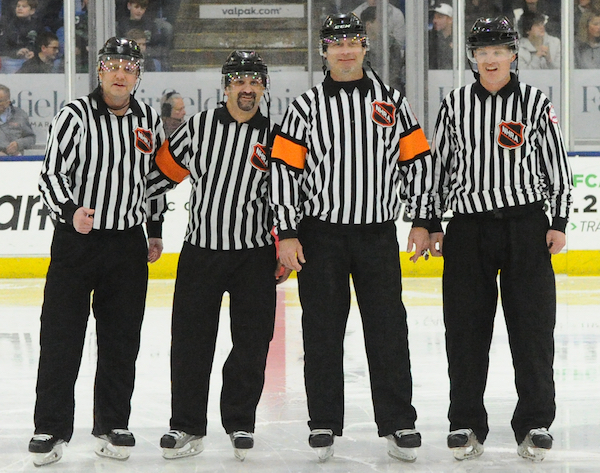 Those who have played hockey at any level have a built-in advantage should they consider the officiating avocation: the ability to skate. Unlike officiating in any other sport, skating is a prerequisite. This makes the pool limited, and almost solely composed of former players. Smolinski offers this advice.
Those who have played hockey at any level have a built-in advantage should they consider the officiating avocation: the ability to skate. Unlike officiating in any other sport, skating is a prerequisite. This makes the pool limited, and almost solely composed of former players. Smolinski offers this advice.
“I prefer sticking with high school because I think there’s more decorum, more administrative structure. Kids are playing for their schools, there’s loyalty there,” said Smolinski. “And there is more accountability. People need report to athletic directors and supervisors. Other levels can be more loosely governed, or a bit more maverick in nature. Moms and dads get involved more, coaches maybe know a little less,” said Smolinski.
He has, in fact, worked a handful of non-school games, and there’s a stark difference.
“I wanted to see what was going on, and I see it first-hand,” Smolinski said. “There are some crazy people and parents out there, and these guys are getting absolutely tortured. I’ve been tortured. There has to be a level of respect for what officials do. I think schools can rein that in a little more. All the guys I’ve met give up a lot of time and work hard because they love to do it and love the game.”
All sports need an assist from school administration and from those who once played the games to keep the officials recruitment moving in the right direction. People like Smolinski can help.
“He clearly doesn’t need to do this, and that’s what makes it so fantastic,” DiCristofaro said. “We need more people who have played – at any level – to do what he’s done and stay in the game as officials.”
Smolinski continues to promote the game in other ways as well. Currently, he is involved in the NHL’s Learn To Play initiative, which aims to inspire youth and welcome more families into the hockey community.
“We work hand-in-hand with the NHL Players Association for player development and industry growth,” Smolinski said. “Ages 5 to 9 are introduced to hockey, get head-to-toe gear and instruction, and meet some former players.”
The idea is to have fun first, which can translate into years and maybe even a lifetime in the sport. It’s a lifetime that has given Smolinski so much and continues to do so as he watches it unfold for others from his new vantage point.
PHOTOS (Top) MHSAA official Bryan Smolinski signals during Friday's Division 1 Semifinal between Brighton and Hartland. (2) Smolinski, a retired NHL standout, communicates with the Bulldogs' bench. (3) Smolinski keeps watch during game play. (4) Smolinski, third from left, with his crew: Michael Andrews, Kevin May and Thomas Robbins.

